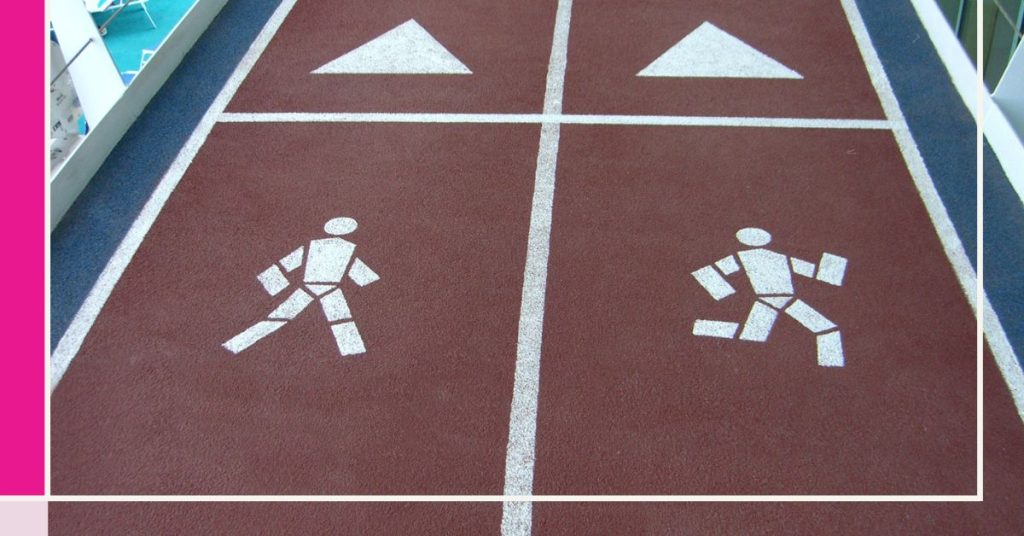Is Walking or Running Better for Weight Loss? A Midlife Runner’s Dilemma
As we age, our bodies change, and so do our fitness goals. For many of us over 40, weight loss becomes a priority for maintaining our health and energy levels. But with so many options out there, choosing the right exercise can feel like a marathon in itself.
One of the most common questions we hear is: is walking or running better for weight loss? The answer isn’t as simple as you might think. Both activities offer unique benefits, and the “best” choice depends on your individual goals, fitness level, and personal preferences. At Midlife Runners Paradise, we believe in finding what works for you, not just following the latest trends. So, let’s explore both options and help you conquer the scale with the right choice for your journey.
Burning Calories: The Engine of Weight Loss
Let’s get down to the nitty-gritty: calories. To lose weight, you need to burn more calories than you consume. Both walking and running torch calories, but they do so at different rates.
Think of it like this: running is like driving a sports car, burning fuel (calories) quickly, while walking is more like cruising in a sedan, using less fuel but still getting you where you need to go.
On average, a 150-pound person burns roughly 100 calories per mile when walking at a moderate pace (around 3.5 mph). In contrast, that same person burns approximately double that amount – 200 calories per mile – when running at a pace of 6 mph.
So, if your goal is to burn a large number of calories in a shorter amount of time, running might be the way to go. But don’t count out walking! Even though it burns fewer calories per minute, it’s a lower-impact exercise that’s easier on your joints. This means you can often walk for longer periods, ultimately burning a similar number of calories as you would during a shorter run.
The key takeaway here is that both walking and running can be effective tools for weight loss. The choice ultimately boils down to your individual preferences and fitness level.
Walking for Weight Loss: A Step in the Right Direction
Walking might not seem like the most glamorous exercise, but it’s a powerhouse for weight loss, especially for those of us over 40. It’s accessible, low-impact, and easy to incorporate into your daily routine – no fancy gym membership or expensive equipment required.
Here’s why walking deserves a spot in your weight loss toolkit:
- Joint-Friendly: Unlike running, walking puts less stress on your joints, making it a sustainable option for long-term fitness. You can enjoy the benefits without worrying about overuse injuries.
- Everyday Integration: Squeeze in a walk during your lunch break, stroll around your neighborhood after dinner, or even power-walk while running errands. It’s easy to fit walking into your daily life.
- Stress Reduction: Walking not only burns calories but also helps reduce stress, which can contribute to weight gain. It’s a win-win for your mind and body.
- Improved Mood: The rhythmic movement and fresh air can boost your mood and motivation, making it easier to stick with your weight loss journey.
Don’t underestimate the power of putting one foot in front of the other. With consistency and a little effort, walking can lead to significant weight loss and a healthier you.
Running for Weight Loss: A Fast Track to Your Goals
If you’re looking to shed pounds and get your heart pumping, running can be a powerful tool in your weight loss arsenal. It’s a high-energy activity that blasts calories and offers a range of other benefits:
- Efficient Calorie Burn: As we mentioned earlier, running torches calories faster than walking. This makes it a great choice if you’re short on time but still want to make a significant dent in your calorie deficit.
- Cardiovascular Health: Running is a fantastic cardio workout, strengthening your heart, lungs, and circulatory system. A strong heart is essential for overall health and longevity, and it can make your runs easier over time.
- Metabolism Boost: Regular running revs up your metabolism, helping you burn more calories even at rest. This is a major plus for weight loss, especially as we get older.
- Mental Clarity and Mood Enhancement: Running releases endorphins, those feel-good chemicals that can reduce stress and improve your mood. This is a powerful motivator to keep lacing up those shoes and hitting the pavement.
If you’re looking for a fast and effective way to shed pounds, running is definitely worth considering. However, it’s important to listen to your body and progress gradually, especially if you’re new to running. Ease into it with a run-walk approach, and don’t hesitate to seek guidance from a qualified professional.
The Power Duo: Combining Walking and Running for Maximum Results
Why choose one when you can have the best of both worlds? Combining walking and running is a smart strategy for weight loss, especially for midlife runners. This approach offers a balanced way to reap the benefits of both exercises while minimizing the risk of injury.
Interval Training: Alternate between bursts of running and recovery periods of walking. This not only makes your workouts more exciting but also challenges your body in different ways, leading to greater calorie burn and improved fitness. You can customize the intervals to match your fitness level, gradually increasing the running segments as you get stronger.
Run/Walk Strategy: This is the heart of our Midlife Runners Paradise framework. It involves a planned combination of running and walking intervals throughout your workout. For example, you might run for five minutes, walk for one minute, and repeat this cycle for the duration of your run. This approach allows you to cover longer distances and maintain a consistent pace, while giving your body time to recover.
The beauty of combining walking and running is the flexibility it offers. You can tailor your workouts to match your energy levels and goals each day. It’s a sustainable and effective approach that can keep you motivated and moving towards your weight loss goals.
Your Personalized Path to Weight Loss: Choosing the Right Fit
No two runners are alike, and that’s why your weight loss journey should be tailored to your unique needs and goals. Here’s how to decide whether walking or running is the right fit for you:
Beginners: If you’re new to exercise or returning after a break, walking is a great starting point. It’s a gentle way to build stamina, strengthen your muscles, and get your body moving. As you progress, you can gradually incorporate short running intervals or increase your walking pace to ramp up the intensity.
Experienced Runners: If you’re already a seasoned runner, keep doing what you love! Running offers a great calorie burn and a multitude of health benefits. But remember, it’s important to listen to your body. If you experience pain or discomfort, don’t be afraid to slow down, take a walk break, or even switch to walking altogether for a while.
Injury or Joint Issues: If you have any existing injuries or concerns about the impact on your joints, walking is a safer bet. It’s a lower-impact exercise that can still help you achieve your weight loss goals without putting unnecessary stress on your body.
Weight Loss Goals: Consider your individual goals. If you’re looking for a quick calorie burn and a more intense workout, running might be your best bet. But if you prefer a sustainable, low-impact activity that you can easily incorporate into your daily routine, walking might be the better choice.
Remember, the best exercise is the one you’ll stick with. Listen to your body, set realistic goals, and don’t be afraid to experiment. Whether you choose walking, running, or a combination of both, the most important thing is to find a routine that you enjoy and that fits seamlessly into your life.
Boost Your Weight Loss Results: Tips for Walking and Running Success
Whether you choose walking, running, or a mix of both, these practical tips can help you supercharge your weight loss journey:
- Consistency is Key: Make walking or running a regular part of your routine. Aim for at least 30 minutes of moderate-intensity exercise most days of the week. Set realistic goals and gradually increase your duration or intensity over time.
- Track Your Progress: Keep a log of your workouts to monitor your progress and stay motivated. You can use a simple notebook or a fitness tracking app. Seeing how far you’ve come can be a powerful motivator.
- Incorporate Strength Training: Add strength training exercises to your routine to build muscle, boost your metabolism, and burn more calories throughout the day. Focus on exercises that target major muscle groups like squats, lunges, push-ups, and rows.
- Prioritize Nutrition: Weight loss is about more than just exercise. Pay attention to your diet and focus on whole, unprocessed foods like fruits, vegetables, lean proteins, and healthy fats. Consider working with a registered dietitian to create a personalized meal plan that supports your goals.
- Listen to Your Body: Pay attention to your body’s signals and adjust your workouts as needed. If you’re feeling pain, don’t push through it. Take rest days when you need them, and don’t be afraid to modify your routine if it’s not working for you.
Remember, weight loss is a journey, not a sprint (or even a long run!). Celebrate your successes, learn from your setbacks, and most importantly, enjoy the process of getting fitter and healthier.
Your Weight Loss Questions, Answered
We know you have questions about the best way to reach your goals, so let’s tackle some common ones:
Q: I hate running. Can I still lose weight just by walking?
Absolutely! Walking is a fantastic way to lose weight and improve your health. It might take a bit longer to see results compared to running, but consistency is key. By walking regularly and incorporating other healthy habits, you can absolutely achieve your weight loss goals.
Q: I’m worried about the impact of running on my knees. Is it safe?
If you have concerns about your joints, start with walking and gradually introduce running as your body adapts. Proper footwear and good running form can also reduce the impact. Consider consulting a physical therapist or running coach for guidance.
Q: Can I lose weight by walking or running on a treadmill?
Definitely! Treadmill workouts can be just as effective as outdoor exercise. You can control the pace, incline, and environment, making it a convenient option. Just remember to vary your workouts to keep things interesting and challenge your body.
Q: How often should I walk or run to lose weight?
Aim for at least 150 minutes of moderate-intensity exercise per week, which can be broken down into shorter sessions throughout the week. This could mean walking for 30 minutes five days a week or running for 20 minutes three times a week.
Q: What if I don’t see results right away?
Be patient and persistent. Weight loss takes time and effort, and there will be ups and downs along the way. Focus on making healthy choices, listen to your body, and don’t give up!
Finding Your Stride: The Winning Strategy for Weight Loss
When it comes to weight loss, there’s no one-size-fits-all answer. Both walking and running can be powerful tools, each with its unique advantages.
Running offers a faster calorie burn and a more intense cardiovascular workout, making it a great choice for those looking for quick results and a challenge. However, it can be harder on your joints and may not be suitable for everyone, especially beginners or those with pre-existing injuries.
Walking, on the other hand, is a gentler, more accessible option that’s perfect for all fitness levels. While it may not burn as many calories per minute as running, it’s a sustainable activity that you can easily incorporate into your daily life.
The best approach? It often lies somewhere in the middle. Combining walking and running in a structured routine can give you the best of both worlds, offering a balanced and effective way to shed pounds while minimizing the risk of injury.
Ultimately, the best choice for you depends on your individual preferences, fitness level, and goals. If you’re not sure where to start, don’t hesitate to reach out to a healthcare professional or a certified fitness trainer. At Midlife Runners Paradise, we’re passionate about empowering you to find the path that leads to a healthier, happier you. So, lace up your shoes, hit the road, and discover the joy of movement that brings you closer to your weight loss goals.




